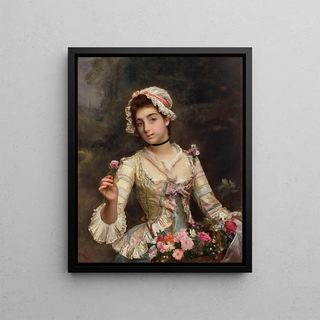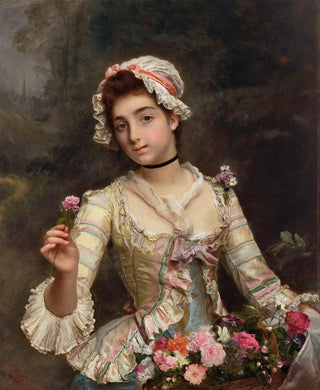Art print | The flower girl - Gustave Jean Jacquet


View from behind

Frame (optional)
In the fascinating universe of art, some works transcend time and space, captivating the eye and mind of viewers. "La bouquetière" by Gustave Jean Jacquet is one of those iconic pieces that evoke an era when beauty and femininity were celebrated with rare intensity. This painting, both delicate and vibrant, transports us to a world where flowers and colors intertwine to create a mesmerizing visual harmony. The depiction of a young woman, gracefully holding a bouquet, embodies softness and lightness, while revealing an emotional depth that invites contemplation. It is this ability to evoke feelings that is found in the art print La bouquetière - Gustave Jean Jacquet, offering an entry point into the artistic imagination of the late 19th century.
Style and uniqueness of the work
Gustave Jean Jacquet's style is characterized by finesse and elegance that are uniquely his own. In "La bouquetière," he manages to capture the very essence of feminine beauty through delicate brushstrokes and a palette of nuanced colors. The flowers, with their brilliance and diversity, are not merely accessories but essential elements that dialogue with the central figure. Each petal seems to come alive with its own life, while light plays on the contours of the young woman's face, highlighting her grace and serenity. The work stands out for its subtle impressionism, where details are suggested rather than defined, allowing the viewer to interpret and feel the work in a personal way. This approach gives "La bouquetière" an atmosphere that is both intimate and universal, paying homage to the ephemeral beauty of nature and femininity.
The artist and his influence
Gustave Jean Jacquet, born in 1846, is an artist whose work was heavily influenced by the artistic movements of his time, notably realism and impressionism. His career, marked by success, allowed him to establish himself as a major figure in 19th-century French art. Jacquet was able to capture the spirit of the era, drawing inspiration from themes of everyday life

Matte finish

View from behind

Frame (optional)
In the fascinating universe of art, some works transcend time and space, captivating the eye and mind of viewers. "La bouquetière" by Gustave Jean Jacquet is one of those iconic pieces that evoke an era when beauty and femininity were celebrated with rare intensity. This painting, both delicate and vibrant, transports us to a world where flowers and colors intertwine to create a mesmerizing visual harmony. The depiction of a young woman, gracefully holding a bouquet, embodies softness and lightness, while revealing an emotional depth that invites contemplation. It is this ability to evoke feelings that is found in the art print La bouquetière - Gustave Jean Jacquet, offering an entry point into the artistic imagination of the late 19th century.
Style and uniqueness of the work
Gustave Jean Jacquet's style is characterized by finesse and elegance that are uniquely his own. In "La bouquetière," he manages to capture the very essence of feminine beauty through delicate brushstrokes and a palette of nuanced colors. The flowers, with their brilliance and diversity, are not merely accessories but essential elements that dialogue with the central figure. Each petal seems to come alive with its own life, while light plays on the contours of the young woman's face, highlighting her grace and serenity. The work stands out for its subtle impressionism, where details are suggested rather than defined, allowing the viewer to interpret and feel the work in a personal way. This approach gives "La bouquetière" an atmosphere that is both intimate and universal, paying homage to the ephemeral beauty of nature and femininity.
The artist and his influence
Gustave Jean Jacquet, born in 1846, is an artist whose work was heavily influenced by the artistic movements of his time, notably realism and impressionism. His career, marked by success, allowed him to establish himself as a major figure in 19th-century French art. Jacquet was able to capture the spirit of the era, drawing inspiration from themes of everyday life






